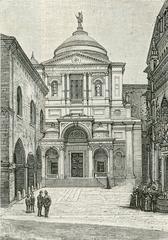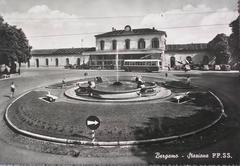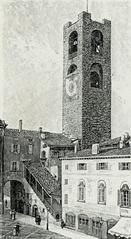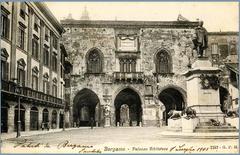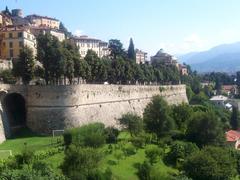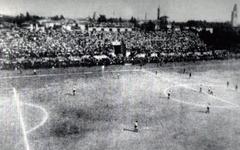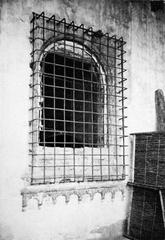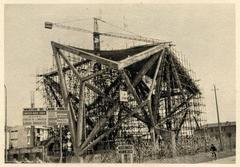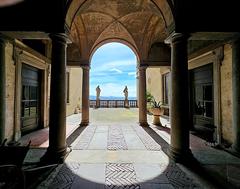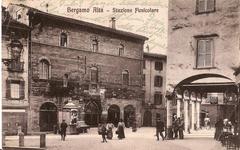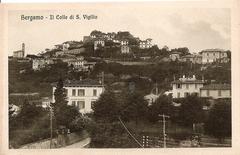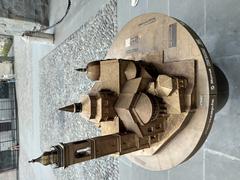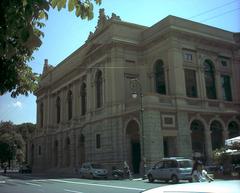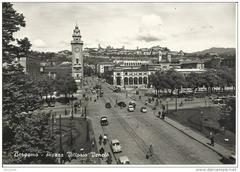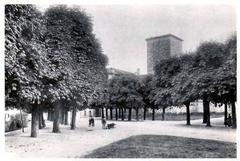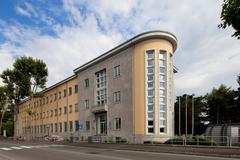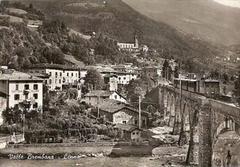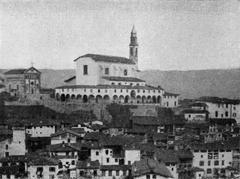
Astino Monastery Visiting Hours, Tickets, and Travel Guide in Bergamo, Italy
Date: 04/07/2025
Introduction
Nestled in the peaceful Astino Valley just outside Bergamo, Italy, Astino Monastery (Monastero di Astino) is a striking testament to centuries of religious devotion, architectural transformation, and cultural vitality. Established in the late 11th century by the Vallombrosan order—a reform branch of the Benedictines—the monastery has played a pivotal role in the spiritual, social, and artistic landscape of Bergamo. Over time, it has evolved from a secluded spiritual retreat into a vibrant cultural hub, drawing visitors eager to explore its layered history, remarkable architecture, and natural surroundings (Fondazione MIA; Wikipedia).
This detailed guide provides everything you need to know for your visit: from an overview of Astino’s history and architectural highlights to practical information on visiting hours, tickets, accessibility, transportation, special events, and nearby attractions. Whether you’re a history enthusiast, art lover, or nature explorer, Astino Monastery promises a rich and memorable experience (Visit Bergamo; Catellani & Smith).
Astino Monastery Through the Ages
Founding and Vallombrosan Beginnings (11th–12th Centuries)
Astino Monastery was founded in the late 11th century by Bertario, a monk from Brescia and follower of St. Giovanni Gualberto, founder of the Vallombrosan Order. The earliest records date to 1107, documenting land purchases for the monastery’s construction (Fondazione MIA). By 1142, the monastery had expanded its role to include a hospital and charitable consortium dedicated to caring for the sick and poor, setting the tone for centuries of community service.
Medieval Expansion and Influence (13th–15th Centuries)
During the 13th and 14th centuries, Astino flourished both spiritually and economically. It became a haven for notable religious exiles, such as Bishop Guala de’ Roniis, and expanded its landholdings to support agricultural and mining activities. The monastery’s influence reached deep into local society, shaping the region’s spiritual and economic development (Visit Bergamo; Fondazione MIA).
Renaissance Renewal and Artistic Flourishing (15th–16th Centuries)
The 15th and 16th centuries marked a period of significant architectural and artistic transformation. Romanesque foundations were elegantly blended with Renaissance and Baroque elements. Architectural highlights from this era include the cloister with its arcaded walkways, the robust southwest tower, and the Church of the Holy Sepulchre, which features a cruciform plan and preserved frescoes (Visit Bergamo; Italia.it).
Suppression and Secularization (18th–19th Centuries)
Napoleonic reforms in 1797 led to the monastery’s suppression, with its assets transferred to the Ospedale Civile di Bergamo. The complex was later converted into a psychiatric hospital, a use that ironically helped preserve much of its historic structure (Fondazione MIA).
20th Century: Preservation and Agricultural Use
In 1909, Astino gained official recognition as a monument, though parts of the complex continued to be used for agriculture. It retained a rural character and remained largely untouched until recent restoration efforts began (Italia.it).
Modern Restoration and Cultural Revival (21st Century)
Starting in 2007, Fondazione MIA led an ambitious restoration project. Astino Monastery reopened in 2015 as a cultural venue, hosting exhibitions, concerts, and educational events. The cloister now features a seasonal café, and the adjacent Valle della Biodiversità offers botanical tours and nature walks (Fondazione MIA; Bergamo by Tuk Tuk).
Visitor Information
Opening Hours
- General Opening: Saturdays and Sundays, 9:30 a.m. – 12:30 p.m. and 2:00 p.m. – 5:30 p.m.
- Church of the Holy Sepulchre: Same as above; Mass is celebrated Sundays at 4:00 p.m.
- Botanical Garden (“Valle della Biodiversità”): Daily, 10:00 a.m. – 12:00 p.m. and 3:00 p.m. – 7:00 p.m.
Tip: Hours may vary seasonally or on holidays—always check the official website before visiting.
Tickets and Admission
- Self-Guided Entry: Free to monastery grounds and general areas.
- Church of the Holy Sepulchre: €2
- Church + Refectory: €3
- Guided Tours: Available by appointment; prices vary.
- Combined Museum Ticket: “Museum of Stories” pass for €14, valid 48 hours for multiple Bergamo attractions.
Tickets can be purchased on-site or pre-booked for guided tours (Visit Bergamo; Eventbrite).
Accessibility
- Mobility: Paved paths and gentle slopes provide good access for most visitors. Some historic interiors may have steps or uneven flooring.
- Assistance: Available on request.
- Restrooms: On-site.
Getting There
- By Car: About 10 minutes from Bergamo city center; parking available but can fill up on weekends.
- By Public Transport: Local buses from Bergamo reach the valley; a short walk is required from the stop (Visit Bergamo).
- By Bicycle/Foot: Scenic walking and cycling paths connect Astino to Bergamo neighborhoods and nearby hills (Live the World).
What to See and Do
Architectural and Artistic Treasures
- Chiesa del Santo Sepolcro: Features a unique cross-shaped plan, Romanesque façade, Renaissance choir, and early frescoes.
- Refectory: Houses a restored “Last Supper” by Alessandro Allori, a significant Renaissance artwork.
- Cloister: Romanesque arcades, tranquil garden, and seasonal café (Catellani & Smith).
- Towers and Courtyards: Explore architectural layers from different eras.
Nature and Outdoor Activities
- Valle della Biodiversità: Botanical gardens with themed plant collections; free entry.
- Hiking and Cycling: Well-marked paths lead to scenic viewpoints and neighboring districts (Live the World).
- Picnicking: Expansive lawns are ideal for picnics; local restaurants offer regional cuisine.
Culinary Experience
- Caffè – Pasticceria Cavour 1880: Seasonal terrace in the cloister; managed by the renowned Cerea family (Catellani & Smith).
- Nearby Dining: Sample traditional Bergamasque dishes and wines at local establishments.
Special Events and Guided Tours
- Guided Tours: Explore Astino’s history, architecture, and spiritual legacy; book in advance (Eventbrite).
- Cultural Events: Art exhibitions, concerts, and food festivals—check the official event calendar.
- Educational Programs: Workshops and talks on history, art, and biodiversity.
Travel Tips and Practical Advice
- Dress Modestly: Especially in religious spaces or during Mass.
- Photography: Allowed in most areas; avoid flash and respect signage.
- Best Times to Visit: Spring and autumn for mild weather and natural beauty; summer for events and café terrace; winter for tranquility.
- Facilities: Restrooms and free Wi-Fi in select areas; no permanent gift shop, but local crafts may be available during events.
- Pets: Allowed on leash outdoors, not inside the church or refectory.
Combine Your Visit
- Bergamo’s Upper Town (Città Alta): Medieval walls, Piazza Vecchia, and Accademia Carrara art gallery.
- Parco dei Colli di Bergamo: Hiking, nature walks, and panoramic views.
- San Vigilio and Bastia Hills: More trails and historic sites (Incoming Bergamo).
Frequently Asked Questions (FAQ)
What are Astino Monastery’s opening hours?
Saturdays and Sundays, 9:30 a.m.–12:30 p.m. and 2:00 p.m.–5:30 p.m.; check for seasonal updates.
Is there an admission fee?
General grounds are free; €2 for the church, €3 for church and refectory, or via combined ticket.
Are guided tours available?
Yes, free or paid tours are offered—advance booking recommended.
Is Astino Monastery accessible for those with disabilities?
Most outdoor areas are accessible; some historic interiors have steps or uneven floors.
Can I picnic or dine on site?
Yes, picnicking is encouraged; café in the cloister is open seasonally.
Visuals and Media Recommendations
- Official photo gallery for images of the monastery, frescoes, and valley.
- Virtual tours and interactive maps on Bergamo tourism platforms.
- Alt text recommendations: “Astino Monastery exterior in Bergamo,” “Cloister and gardens at Astino,” “Last Supper by Alessandro Allori in Astino Refectory.”
Summary and Final Travel Tips
Astino Monastery is a must-visit gem among Bergamo’s historical and cultural sites. Its harmonious blend of Romanesque, Renaissance, and Baroque architecture, set against the tranquil Astino Valley, provides a unique experience for all types of travelers. With regular opening hours, affordable tickets, guided tours, and seasonal events, Astino is accessible and engaging year-round.
Before you go, check the latest opening times and event schedules on official platforms. Consider combining your visit with other Bergamo attractions for a fuller experience. Download the Audiala app for guided audio tours and stay connected via social media for updates and travel inspiration.
Sources
- Fondazione MIA
- Wikipedia
- Visit Bergamo
- Bergamo by Tuk Tuk
- Catellani & Smith
- Eventbrite
- Tusoperator
- Forever Out Of Office
- Live the World
- Incoming Bergamo
- Italia.it













